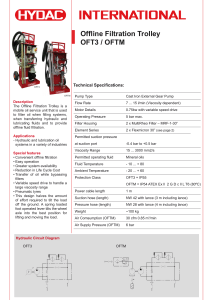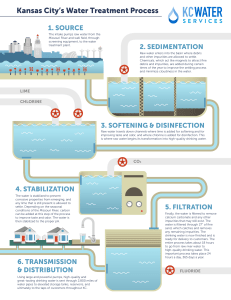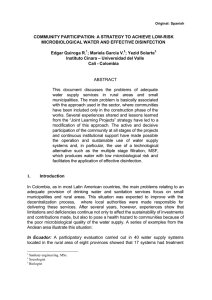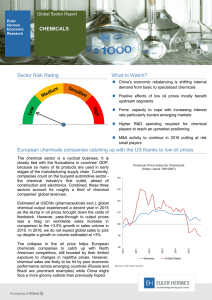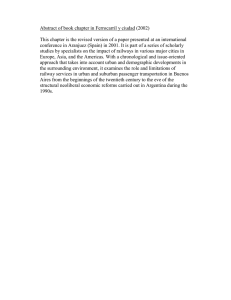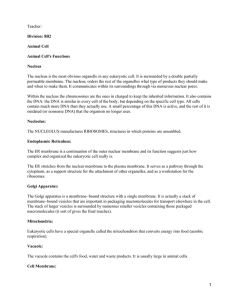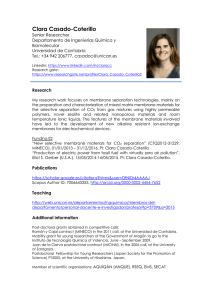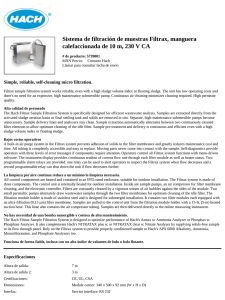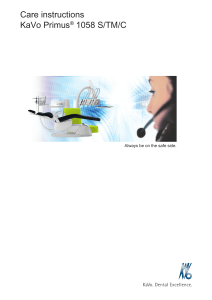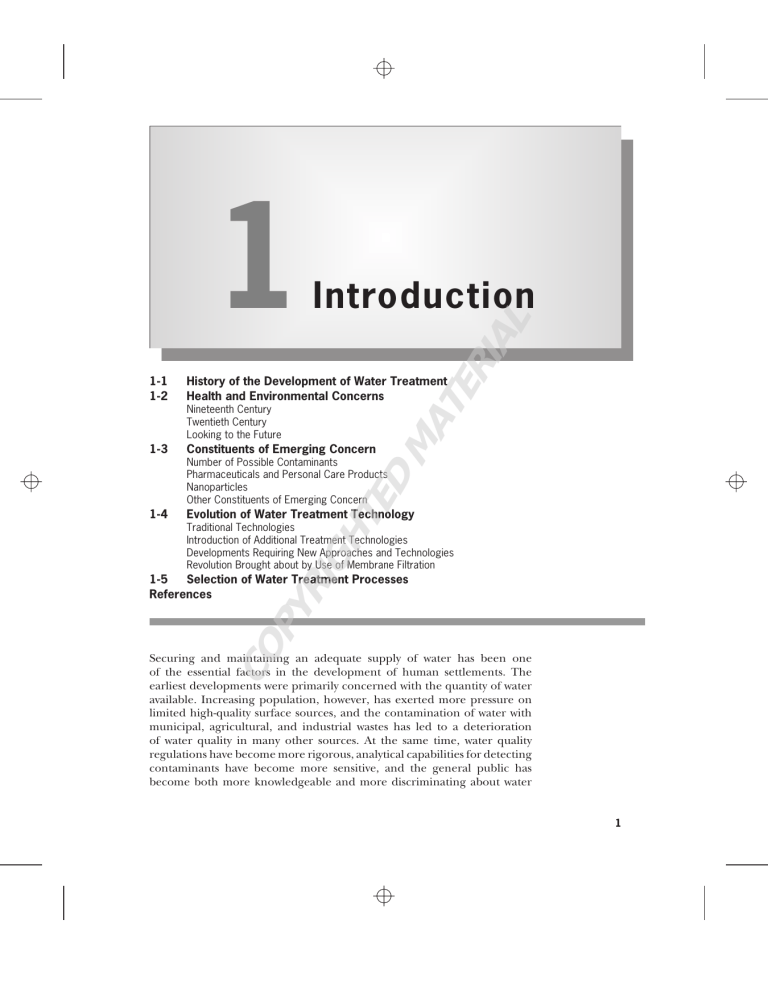
AL TE History of the Development of Water Treatment Health and Environmental Concerns Nineteenth Century Twentieth Century Looking to the Future 1-3 Constituents of Emerging Concern MA 1-1 1-2 Introduction RI 1 Evolution of Water Treatment Technology HT 1-4 ED Number of Possible Contaminants Pharmaceuticals and Personal Care Products Nanoparticles Other Constituents of Emerging Concern IG Traditional Technologies Introduction of Additional Treatment Technologies Developments Requiring New Approaches and Technologies Revolution Brought about by Use of Membrane Filtration CO PY R 1-5 Selection of Water Treatment Processes References Securing and maintaining an adequate supply of water has been one of the essential factors in the development of human settlements. The earliest developments were primarily concerned with the quantity of water available. Increasing population, however, has exerted more pressure on limited high-quality surface sources, and the contamination of water with municipal, agricultural, and industrial wastes has led to a deterioration of water quality in many other sources. At the same time, water quality regulations have become more rigorous, analytical capabilities for detecting contaminants have become more sensitive, and the general public has become both more knowledgeable and more discriminating about water 1 2 1 Introduction quality. Thus, the quality of a water source cannot be overlooked in water supply development. In fact, virtually all sources of water require some form of treatment before potable use. Water treatment can be defined as the processing of water to achieve a water quality that meets specified goals or standards set by the end user or a community through its regulatory agencies. Goals and standards can include the requirements of regulatory agencies, additional requirements set by a local community, and requirements associated with specific industrial processes. The evolution of water treatment practice has a rich history of empirical and scientific developments and challenges met and overcome. The primary focus of this book is the application of water treatment for the production of potable, or drinking, water on a municipal level. Water treatment, however, encompasses a much wider range of problems and ultimate uses, including home treatment units, community treatment plants, and facilities for industrial water treatment with a wide variety of water quality requirements that depend on the specific industry. Water treatment processes are also applicable to remediation of contaminated groundwater and other water sources and wastewater treatment when the treated wastewater is to be recycled for new uses. The issues and processes covered in this book are relevant to all of these applications. This book thoroughly covers a full range of topics associated with water treatment, starting in Chaps. 2 and 3 with an in-depth exploration of the physical, chemical, and microbiological aspects that affect water quality. Chapter 4 presents an overview of factors that must be considered when selecting a treatment strategy. Chapters 5 through 8 explain background concepts necessary for understanding the principles of water treatment, including fundamentals of chemical reactions, chemical reactors, mass transfer, and oxidation/reduction reactions. Chapters 9 through 18 are the heart of the book, presenting in-depth material on each of the principal unit processes used in municipal water treatment. Chapters 19 through 22 present supplementary material that is essential to an overall treatment system, including issues related to disinfection by-products, treatment strategies for specific contaminants, processing of treatment residuals, and corrosion in water distribution systems. The final chapter, Chap. 23, synthesizes all the previous material through a series of case studies. The purpose of this introductory chapter is to provide some perspective on the (1) historical development of water treatment, (2) health concerns, (3) constituents of emerging concern, (4) evolution of water treatment technology, and (5) selection of water treatment processes. The material presented in this chapter is meant to serve as an introduction to the chapters that follow in which these and other topics are examined in greater detail. 1-2 Health and Environmental Concerns 3 1-1 History of the Development of Water Treatment Some of the major events and developments that contributed to our understanding of the importance of water quality and the need to provide some means of improving the quality of natural waters are presented in Table 1-1. As reported in Table 1-1, one of the earliest water treatment techniques (boiling of water) was primarily conducted in containers in the households using the water. From the sixteenth century onward, however, it became increasingly clear that some form of treatment of large quantities of water was essential to maintaining the water supply in large human settlements. 1-2 Health and Environmental Concerns The health concerns from drinking water have evolved over time. While references to filtration as a way to clarify water go back thousands of years, the relationship between water quality and health was not well understood or appreciated. Treatment in those days had as much to do with the aesthetic qualities of water (clarity, taste, etc.) as it did on preventing disease. The relationship between water quality and health became clear in the nineteenth century, and for the first 100 years of the profession of water treatment engineering, treatment was focused on preventing waterborne disease outbreaks. Since 1970, however, treatment objectives have become much more complex as public health concerns shifted from acute illnesses to the chronic health effects of trace quantities of anthropogenic (manmade) contaminants. In the middle of the nineteenth century it was a common belief that diseases such as cholera and typhoid fever were primarily transmitted by breathing miasma, vapors emanating from a decaying victim and drifting through the night. This view began to change in the last half of that century. In 1854, Dr. John Snow demonstrated that an important cholera epidemic in London was the result of water contamination (Snow, 1855). Ten years later, Dr. Louis Pasteur articulated the germ theory of disease. Over the next several decades, a number of doctors, scientists, and engineers began to make sense of the empirical observations from previous disease outbreaks. By the late 1880s, it was clear that some important epidemic diseases were often waterborne, including cholera, typhoid fever, and amoebic dysentery (Olsztynski, 1988). As the nineteenth century ended, methods such as the coliform test were being developed to assess the presence of sewage contamination in a water supply (Smith, 1893), and the conventional water treatment process (coagulation/flocculation/sedimentation/ filtration) was being developed as a robust way of removing contamination from municipal water supplies (Fuller, 1898). Nineteenth Century 4 1 Introduction Table 1-1 Historical events and developments that have been precursors to development of modern water supply and treatment systems Period 4000 B.C. Event Ancient Sanskrit and Greek writings recommend water treatment methods. In the Sanskrit Ousruta Sanghita it is noted that ‘‘impure water should be purified by being boiled over a fire, or being heated in the sun, or by dipping a heated iron into it, or it may be purified by filtration through sand and coarse gravel and then allowed to cool.’’ 3000 to 1500 B.C. Minoan civilization in Crete develops technologies so advanced they can only be compared to modern urban water systems developed in Europe and North America in the second half of the nineteenth century. Technology is exported to Mediterranean region. 1500 B.C. Egyptians reportedly use the chemical alum to cause suspended particles to settle out of water. Pictures of clarifying devices were depicted on the wall of the tomb of Amenophis II at Thebes and later in the tomb of Ramses II. Fifth century B.C. Hippocrates, the father of medicine, notes that rainwater should be boiled and strained. He invents the ‘‘Hippocrates sleeve,’’ a cloth bag to strain rainwater. Third century B.C. Public water supply systems are developed at the end of the third century B.C. in Rome, Greece, Carthage, and Egypt. 340 B.C. to 225 A.D. Roman engineers create a water supply system that delivers water [490 megaliters per day (130 million gallons per day)] to Rome through aqueducts. 1676 Anton van Leeuwenhoek first observes microorganisms under the microscope. 1703 French scientist La Hire presents a plan to French Academy of Science proposing that every household have a sand filter and rainwater cistern. 1746 French scientist Joseph Amy is granted the first patent for a filter design. By 1750 filters composed of sponge, charcoal, and wool could be purchased for home use. 1804 The first municipal water treatment plant is installed in Paisley, Scotland. The filtered water is distributed by a horse and cart. 1807 Glasgow, Scotland, is one of the first cities to pipe treated water to consumers. 1829 Installation of slow sand filters in London, England. 1835 Dr. Robley Dunlingsen, in his book Public Health, recommends adding a small quantity of chlorine to make contaminated water potable. 1846 Ignaz Semmelweiss (in Vienna) recommends that chlorine be used to disinfect the hands of physicians between each visit to a patient. Patient mortality drops from 18 to 1 percent as a result of this action. 1854 John Snow shows that a terrible epidemic of Asiatic cholera can be traced to water at the Broad Street Well, which has been contaminated by the cesspool of a cholera victim recently returned from India. Snow, who does not know about bacteria, suspects an agent that replicates itself in the sick individuals in great numbers and exits through the gastrointestinal tract, and is transported by the water supply to new victims. 1854 Dr. Falipo Pacini, in Italy, identifies the organism that causes Asiatic cholera, but his discovery goes largely unnoticed. 1-2 Health and Environmental Concerns 5 Table 1-1 (Continued) Period Event 1856 Thomas Hawksley, civil engineer, advocates continuously pressurized water systems as a strategy to prevent external contamination. 1864 Louis Pasteur articulates the germ theory of disease. 1874 Slow sand filters are installed in Poughkeepsie and Hudson, New York. 1880 Karl Eberth isolates the organism (Salmonella typhosa) that causes typhoid fever. 1881 Robert Koch demonstrates in the laboratory that chlorine will inactivate bacteria. 1883 Carl Zeiss markets the first commercial research microscope. 1884 Professor Escherich isolates organisms from the stools of a cholera patient that he initially thought were the cause of cholera. Later it is found that similar organisms are also present in the intestinal tracts of every healthy individual as well. Organism eventually named for him (Escherichia coli ). 1884 Robert Koch proves that Asiatic cholera is due to a bacterium, Vibrio cholerea, which he calls the comma bacillus because of its comma-like shape. 1892 A cholera epidemic strikes Hamburg, Germany, while its neighboring city, Altona, which treats its water using slow sand filtration, escapes the epidemic. Since that time, the value of granular media filtration has been widely recognized. 1892 The New York State Board of Health uses the fermentation tube method developed by Theobald Smith for the detection of E. coli to demonstrate the connection between sewage contamination of the Mohawk River and the spread of typhoid fever. 1893 First sand filter built in America for the express purpose of reducing the death rate of the population supplied is constructed at Lawrence, Massachusetts. To this end, the filter proves to be a great success. 1897 G. W. Fuller studies rapid sand filtration [5 cubic meters per square meter per day (2 gallons per square foot per day)] and finds that bacterial removals are much better when filtration is preceded by good coagulation and sedimentation. 1902 The first drinking water supply is chlorinated in Middelkerke, Belgium. Process is actually the ‘‘Ferrochlor’’ process wherein calcium hypochlorite and ferric chloride are mixed, resulting in both coagulation and disinfection. 1903 The iron and lime process of treating water (softening) is applied to the Mississippi River water supplied to St Louis, Missouri. 1906 First use of ozone as a disinfectant in Nice, France. First use of ozone in the United States occurs some four decades later. 1908 George Johnson, a member of Fuller’s consulting firm, helps install continuous chlorination in Jersey City, New Jersey. 1911 Johnson publishes ‘‘Hypochlorite Treatment of Public Water Supplies’’ in which he demonstrates that filtration alone is not enough for contaminated supplies. Adding chlorination to the process of water treatment greatly reduces the risk of bacterial contamination. (continues) 6 1 Introduction Table 1-1 (Continued) Period Event 1914 U.S. Public Health Service (U.S. PHS) uses Smith’s fermentation test for coliform to set standards for the bacteriological quality of drinking water. The standards applied only to water systems that provided drinking water to interstate carriers such as ships and trains. 1941 Eighty-five percent of the water supplies in the United States are chlorinated, based on a survey conducted by U.S. PHS. 1942 U.S. PHS adopts the first comprehensive set of drinking water standards. 1974 Dutch and American studies demonstrate that chlorination of water forms trihalomethanes. 1974 Passage of the Safe Drinking Water Act (SDWA). Source: Adapted from AWWA (1971), Baker (1948), Baker and Taras (1981), Blake (1956), Hazen (1909), Salvato (1992), and Smith (1893). Twentieth Century The twentieth century began with the development of continuous chlorination as a means for bacteriological control, and in the first four decades the focus was on the implementation of conventional water treatment and chlorine disinfection of surface water supplies. By 1940, the vast majority of water supplies in developed countries had ‘‘complete treatment’’ and were considered microbiologically safe. In fact, during the 1940s and 1950s, having a microbiologically safe water supply became one of the principal signposts of an advanced civilization. The success of filtration and disinfection practices led to the virtual elimination of the most deadly waterborne diseases in developed countries, particularly typhoid fever and cholera. FROM BACTERIA TO VIRUSES The indicator systems and the treatment technologies for water treatment focused on bacteria as a cause of waterborne illness. However, scientists demonstrated that there were some infectious agents much smaller than bacteria (viruses) that could also cause disease. Beginning in the early 1940s and continuing into the 1960s, it became clear that viruses were also responsible for some of the diseases of the fecal–oral route, and traditional bacterial tests could not be relied upon to establish their presence or absence. ANTHROPOGENIC CHEMICALS AND COMPOUNDS Concern also began to build about the potential harm that anthropogenic chemicals in water supplies might have on public health. In the 1960s, the U.S. PHS developed some relatively simple tests using carbon adsorption and extraction in an attempt to assess the total mass of anthropogenic compounds in water. Then in the mid-1970s, with the development of the gas chromatograph/mass spectrometer, it became possible to detect these compounds at much lower levels. The concern about the potential 1-2 Health and Environmental Concerns harm of man-made organic compounds in water coupled with improving analytical capabilities has led to a vast array of regulations designed to address these risks. New issues with anthropogenic chemicals will continue to emerge as new chemicals are synthesized, analytical techniques improve, and increasing population density impacts the quality of water sources. DISINFECTION BY-PRODUCTS A class of anthropogenic chemicals of particular interest in water treatment is chemical by-products of the disinfection process itself (disinfection byproducts, or DBPs). DBPs are formed when disinfectants react with species naturally present in the water, most notably natural organic matter and some inorganic species such as bromide. The formation of DBPs increases as the dose of disinfectants or contact time with the water increases. Reducing disinfectant use to minimize DBP formation, however, has direct implications for increasing the risk of illness from microbial contamination. Thus, a trade-off has emerged between using disinfection to control microbiological risks and preventing the formation of undesirable manmade chemicals caused by disinfectants. Managing this trade-off has been one of the biggest challenges of the water treatment industry over the last 30 years. MODERN WATERBORNE DISEASE OUTBREAKS While severe waterborne disease has been virtually eliminated in developed countries, new sources of microbiological contamination of drinking water have surfaced in recent decades. Specifically, pathogenic protozoa have been identified that are zoonotic in origin, meaning that they can pass from animal to human. These protozoan organisms are capable of forming resistant, encysted forms in the environment, which exhibit a high level of resistance to treatment. The resistance of these organisms has further complicated the interrelationship between the requirements of disinfection and the need to control DBPs. In fact, it has become clear that processes that provide better physical removal of pathogens are required in addition to more efficient processes for disinfection. The significance of these new sources of microbiological contamination has become evident in recent waterborne disease outbreaks, such as the outbreaks in Milwaukee, Wisconsin, in 1993 and Walkerton, Ontario, in 2000. In Milwaukee, severe storms caused contamination of the water supply and inadequate treatment allowed Cryptosporidium to enter the water distribution system, leading to over 400,000 cases of gastrointestinal illness and over 50 deaths (Fox and Lytle, 1996). The Walkerton incident was caused by contamination of a well in the local water system by a nearby farm. During the outbreak, estimates are that more than 2300 persons became ill due to E. coli O157:H7 and Campylobacter species (Clark et al., 2003). Of the 1346 cases that were reported, 1304 (97 percent) were considered to be directly due to the drinking water. Sixty-five 7 8 1 Introduction persons were hospitalized, 27 developed hemolytic uremic syndrome, and 6 people died. Another challenge associated with microbial contamination is that the portion of the world’s population that is immunocompromised is increasing over time, due to increased life spans and improved medical care. The immunocompromised portion of the population is more susceptible to health risks, including those associated with drinking water. Looking to the Future As the twenty-first century begins, the challenges of water treatment have become more complex. Issues include the identification of new pathogens such as Helicobacter pylori and the noroviruses, new disinfection by-products such as N -nitrosodimethylamine (NDMA), and a myriad of chemicals, including personal care products, detergent by-products, and other consumer products. As analytical techniques improve, it is likely that these issues will grow, and the water quality engineer will face ever-increasing challenges. 1-3 Constituents of Emerging Concern Contaminants and pathogens of emerging concern are by their very nature unregulated constituents that may pose a serious threat to human health. Consequently, they pose a serious obstacle to delivering the quality and quantity of water that the public demands. Furthermore, emerging contaminants threaten the development of more environmentally responsible water resources that do not rely on large water projects involving reservoirs and dams in more pristine environments. Creating acceptable water from water resources that are of lower quality because of contaminants of emerging concern is more expensive, and there is resistance to increased spending for public water supply projects (NRC, 1999). Number of Possible Contaminants The sheer number of possible contaminants is staggering. The CAS (Chemical Abstracts Service, a division of the American Chemical Society) Registry lists more than 55 million unique organic and inorganic chemicals (CAS, 2010a). In the United States, about 70,000 chemicals are used commercially and about 3300 are considered by the U.S. Environmental Protection Agency (EPA) to be high-volume production chemicals [i.e., are produced at a level greater than or equal to 454,000 kg/yr (1,000,000 lb/yr)]. The CAS also maintains CHEMLIST, a database of chemical substances that are the target of regulatory activity someplace in the world; this list currently contains more than 248,000 substances (CAS, 2010b). Pharmaceuticals and Personal Care Products Increasing interconnectedness between surface waters used for discharge of treated wastewater and as a source for potable water systems has created concern about whether trace contaminants can pass through the wastewater treatment system and enter the water supply. Many recent investigations 1-4 Evolution of Water Treatment Technology 9 have found evidence of low concentrations of pharmaceuticals and personal care products (PPCPs) and endocrine disrupting compounds (EDCs) in the source water for many communities throughout the United States and other developed nations. Pharmaceuticals can enter the wastewater system by being excreted with human waste after medication is ingested or because of the common practice of flushing unused medication down the toilet. Pharmaceuticals include antibiotics, analgesics [painkillers such as aspirin, ibuprofen (Advil), acetaminophen (Tylenol)], lipid regulators (e.g., atorvastatin, the active ingredient in Lipitor), mood regulators (e.g., fluoxetine, the active ingredient in Prozac), antiepileptics (e.g., carbamazepine, the active ingredient in many epilepsy and bipolar disorder medications), and hundreds of other medications. Personal care products, which include cosmetics and fragrances, acne medications, insect repellants, lotions, detergents, and other products, can be washed from the skin and hair during washing or showering. Endocrine disrupting chemicals are chemicals that have the capability to interfere with the function of human hormones. EDCs include actual hormones, such as estrogens excreted by females after use of birth-control pills, or other compounds that mimic the function of hormones, such as bisphenol A. Studies have shown that some of these compounds are effectively removed by modern wastewater treatment processes, but others are not. Although the compounds are present at very low concentrations when they are detected, the public is concerned about the potential presence of these compounds in drinking water. The manufacture of nanoparticles is a new and rapidly growing field. Nanoparticles are very small particles ranging from 1 to 100 nanometers (nm) used for applications such as the delivery of pharmaceuticals across the blood–brain barrier. Because nanomaterials are relatively new and the current market is small, a knowledge base of the potential health risks and environmental impacts of nanomaterials is lacking. As the manufacture of nanomaterials increases, along with the potential for discharge to the environment, more research to establish health risks and environmental impacts may be appropriate. Nanoparticles In addition to the constituents listed above, other constituents of emerging concern include (1) fuel oxygenates (e.g., methyl tert-butyl ether, MTBE), (2) N-nitrosodimethylamine (NDMA), (3) perchlorate, (4) chromate, and (5) veterinary medications that originate from concentrated animal-feeding operations. Other Constituents of Emerging Concern 1-4 Evolution of Water Treatment Technology To understand how the treatment methods discussed in this book developed, it is appropriate to consider their evolution. Most of the methods in use at the beginning of the twentieth century evolved out of physical 10 1 Introduction observations (e.g., if turbid water is allowed to stand, a clarified liquid will develop as the particles settle) and the relatively recent (less than 120 years) recognition of the relationship between microorganisms in contaminated water and disease. A list of plausible methods for treating water at the beginning of the twentieth century was presented in a book by Hazen (1909) and is summarized in Table 1-2. It is interesting to note that all of the treatment methods reported in Table 1-2 are still in use today. The most important modern technological development in the field of water treatment not reflected in Table 1-2 is the use of membrane technology. Table 1-2 Summary of methods used for water treatment early in the twentieth century Treatment Method Agent/Objectives I. Mechanical separation ❑ By gravity—sedimentation ❑ By screening—screens, scrubbers, filters ❑ By adhesion—scrubbers, filters II. Coagulation ❑ By chemical treatment resulting in drawing matters together into groups, thereby making them more susceptible to removal by mechanical separation but without any significant chemical change in the water III. Chemical purification ❑ Softening—by use of lime ❑ Iron removal ❑ Neutralization of objectionable acids IV. Poisoning processes (now known as disinfection processes) ❑ Ozone ❑ Sulfate of copper ❑ The object of these processes is to poison and kill objectionable organisms without at the same time adding substances objectionable or poisonous to the users of the water V. Biological processes ❑ Oxidation of organic matter by its use as food for organisms that thereby effect its destruction ❑ Death of objectionable organisms, resulting from the production of unfavorable conditions, such as absence of food (removed by the purification processes) and killing by antagonistic organisms VI. Aeration ❑ Evaporation of gases held in solution that are the cause of objectionable tastes and odors ❑ Evaporation of carbonic acid, a food supply for some kinds of growths ❑ Supplying oxygen necessary for certain chemical purifications and especially necessary to support growth of water-purifying organisms VII. Boiling Source: Adapted from Hazen (1909). ❑ Best household method of protection from disease-carrying waters 1-4 Evolution of Water Treatment Technology 11 For the 100 years following the work of Fuller’s team in Louisville in the late 1880s (see Table 1-1), the focus in the development of water treatment technology was on the further refinement of the technologies previously developed, namely coagulation, sedimentation, filtration, and disinfection with chlorine (see Fig. 1-1). There were numerous developments during that period, among them improvements in the coagulants available, improved understanding of the role of the flocculation process and the optimization of its design, improvements in the design of sedimentation basins, improvements in the design of filter media and in the filter rates that can be safely achieved, and improvements in the control of chlorination and chlorine residuals. These technologies have also been widely deployed, to the point where the vast majority of surface water supplies have treatment of this kind. Traditional Technologies A variety of new treatment technologies were introduced at various times during the twentieth century in response to more complex treatment goals. Ion exchange and reverse osmosis are processes that are able to remove a wide variety of inorganic species. A typical use for ion exchange is the removal of hardness ions (calcium and magnesium). Although ion exchange is typically expensive to implement at the municipal scale, the first large U.S. ion exchange facility was a 75.7 megaliter per day (75.7 ML/d) [20 million gallons per day (20 mgd)] softening plant constructed by the Metropolitan Water District of Southern California in 1946. The first commercial reverse osmosis plant provided potable water to Coalinga, California, in 1965 and had a capacity of 0.019 ML/d (0.005 mgd). Aeration is accomplished by forcing intimate contact between air and water, most simply done by spraying water into the air, allowing the water to splash down a series of steps or platforms, or bubbling air into a tank of water. Early in the history of water treatment, aeration was employed to control tastes and odors associated with anaerobic conditions. The number and type of aeration systems have grown as more source waters have been contaminated with volatile organic chemicals. Organic chemicals can be effectively removed by adsorption onto activated carbon. Adsorption using granular activated carbon was introduced in Hamm, Germany, in 1929 and Bay City, Michigan, in 1930. Powdered activated carbon was used as an adsorbent in New Milford, New Jersey, in 1930. During this time and the next few decades, the use of activated carbon as an adsorbent was primarily related to taste and odor control. In the mid-1970s, however, the increasing concern about contamination of source waters by industrial wastes, agricultural chemicals, and municipal discharges promoted the interest in adsorption for control of anthropogenic contaminants. Introduction of Additional Treatment Technologies During the last three decades of the twentieth century, three developments took place requiring new approaches to treatment. Two of these changes were rooted in new discoveries concerning water quality, and one was the development of a new technology that portends to cause dramatic change Developments Requiring New Approaches and Technologies 12 Influent from surface water 1 Introduction Oxidant/ disinfectant pH Coagulant control Flash Screen mix Filter aid (polymer) Flocculation Sedimentation Disinfectant Granular filtration Liquid processing Residuals processing Clearwell storage Effluent to distribution system Filter washwater Screenings Settled solids Filter waste Filter-to-waste water to dewatering washwater to recycle to head of to recovery plant system Water return from filter washwater recovery system and solids dewatering (a) (b) (c) (d) (e) Figure 1-1 Views of conventional treatment technologies: (a) schematic flow diagram used for the treatment of surface water, (b) pumped diffusion flash mixer for chemical addition, (c) flocculation basin, (d) empty sedimentation basin, and (e) granular media filter. 1-5 Selection of Water Treatment Processes 13 in the effectiveness of water treatment. The first discovery concerning water quality was that the oxidants used for disinfecting water, particularly chlorine, react with the natural organic matter in the water supply to form chemical by-products, some of which are suspected carcinogens. The second discovery was that certain pathogenic microorganisms, namely Giardia and Cryptosporidium, can be of zoonotic origin and, therefore, can occur in a water supply that is completely free of wastewater contamination. The final and perhaps most significant change was the development of membrane filtration technologies suitable for the treatment of water on the scale required for domestic supply. Membrane technologies have the potential to completely reject pathogens by size exclusion, a possibility that could substantially improve the safety of drinking water. Further development and refinement of membrane technologies will be required before they reach their full potential. The first membranes were developed near the middle of the twentieth century but initially were only used in limited applications. In the late 1950s membranes began to be used in laboratory applications, most notably as an improvement in the coliform test. By the mid-1960s membrane filtration was widely used for beverages, as a replacement for heat pasteurization as a method of purification and microbiological stabilization. In virtually all of these applications the membranes were treated as disposable items. The idea of treating large volumes of drinking water in this manner seemed untenable. In the mid-1980s, researchers in both Australia and France began to pursue the idea of membrane filtration fibers that could be backwashed after each use, so that the membrane need not be disposed of but could be used on a continuous basis for a prolonged period of time. In the last decade of the twentieth century these products were commercialized, and by the turn of the twenty-first century there were numerous manufacturers of commercial membrane filtration systems and municipal water plants as large as 300 ML/d (80 mgd) were under construction (see Fig. 1-2). Membranes are arguably the most important development in the treatment of drinking water since the year 1900 because they offer the potential for complete and continuous rejection of microbiological contaminants on the basis of size exclusion. 1-5 Selection of Water Treatment Processes To produce water that is safe to drink and aesthetically pleasing, treatment processes must be selected that, when grouped together, can be used to remove specific constituents. The most critical determinants in the selection of water treatment processes are the quality of the water source and the intended use of the treated water. The two principal water sources are groundwater and surface water. Depending on the hydrogeology of a basin, the levels of human activity in the vicinity of the source, and other Revolution Brought about by Use of Membrane Filtration 14 1 Introduction Disinfectant Raw water Cartridge filters or microscreens Screen Reverse osmosis Membrane filtration pH control Clearwell storage Treated water Liquid processing Solids to Water return disposal from washwater recovery system Waste washwater to recovery system Residuals processing and management Concentrate (waste stream) to disposal (a) (b) (c) Figure 1-2 Views of membrane facilities for water treatment: (a) schematic flow diagram for a brackish water desalting plant using membrane filtration and reverse osmosis, (b) membrane filtration system, and (c) reverse osmosis system. factors, a wide range of water qualities can be encountered. Surface waters typically have higher concentrations of particulate matter than groundwater, and groundwater often has increased concentrations of dissolved minerals due to the long contact times between subsurface water with rocks and minerals. Surface water may have more opportunity for exposure to anthropogenic chemicals. Another major distinction is based on the level of dissolved salts or total dissolved solids (TDS) present in the water source. Water containing TDS less than 1000 mg/L is considered to be freshwater, and water with TDS between 1000 and 10,000 mg/L is considered to be brackish water. Freshwater is the most easily used for drinking water purposes, and brackish water can be used under specific circumstances with adequate treatment. Finally, the most abundant water source, the ocean, contains approximately 35,000 mg/L TDS and requires demineralization prior to use. Each of the predominant types of water sources, including natural or man-made lakes and rivers, requires a different treatment strategy. References (a) 15 (b) Figure 1-3 Views of pilot plant test installations: (a) test facilities for evaluation of a proprietary process (the MIEX process; see Chap.16) for the removal of natural organic matter before coagulation, flocculation, sedimentation, and filtration, and (b) reverse osmosis for the removal of dissolved constituents. The steps that are typically involved in the selection and implementation of water treatment plants are 1. Characterization of the source water quality and definition of the treated water quality goals or standards 2. Predesign studies, including pilot plant testing (see Fig. 1-3), process selection, and development of design criteria 3. Detailed design of the selected alternative; 4. Construction 5. Operation and maintenance of the completed facility These five steps may be performed as discrete steps or in combination and require input from a wide range of disciplines, including engineering, chemistry, microbiology, geology, architecture, and financial analysis. Each discipline plays an important role at various stages in the process. The predominant role, however, rests with professional engineers who carry the responsibility for the success of the water treatment process. References AWWA (1971) Water Quality and Treatment: Handbook of Public Water Supply, American Water Works Association, Denver, CO. Baker, M. N. (1948) The Quest for Pure Water , American Water Works Association, New York. Baker, M. N., and Taras, M. J. (1981) The Quest for Pure Water: The History of the Twentieth Century, Vols. 1 and 2, American Water Works Association, Denver, CO. 16 1 Introduction Blake, N. M. (1956) Water for the Cities, Syracuse University Press, Syracuse, NY. CAS (2010a) http://www.cas.org/expertise/cascontent/registry/index.html. CAS (2010b) http://www.cas.org/expertise/cascontent/regulated/index.html. Clark, G. L., Price, L., Ahmed, R., Woodward, D. L., Melito, P. L., Rodgers, F. G., Jamieson, F., Ciebin, B., Li., A., and Ellis, A. (2003) ‘‘Characterization of Waterborne Outbreak-Associated Campylobacter jejuni, Walkerton, Ontario,’’ Emerging Infect. Dis., 9, 10, 1232–1241. Fox, K. R., Lytle, D. A. (1996) ‘‘Milwaukee’s Crypto Outbreak: Investigation and Recommendations,’’ Journal AWWA, 88, 9, 87–94. Fuller, G. (1898) Report on the Investigation into Purification of the Water of the Ohio River at Louisville, Kentucky, D. Van Nostrand Co., New York. Hazen, A. (1909) Clean Water and How to Get It, John Wiley & Sons, New York. NRC (1999) Identifying Future Drinking Water Contaminants, Water Science and Technology Board, National Research Council, National Academy Press, Washington, DC. Olsztynski, J. (1988) ‘‘Plagues and Epidemics,’’ Plumbing Mechanical Mag., 5, 5, 42–56. Salvato, J. A. (1992) Engineering and Sanitation, 4th ed., John Wiley & Sons, New York. Smith, T. (1893) A New Method for Determining Quantitatively the Pollution of Water by Fecal Bacteria, pp. 712–722 in Thirteenth Annual Report for the Year 1892, New York State Board of Health, Albany, NY. Snow, J. (1855) On the Mode of Communication of Cholera, 2nd ed., J. Churchill, London.
